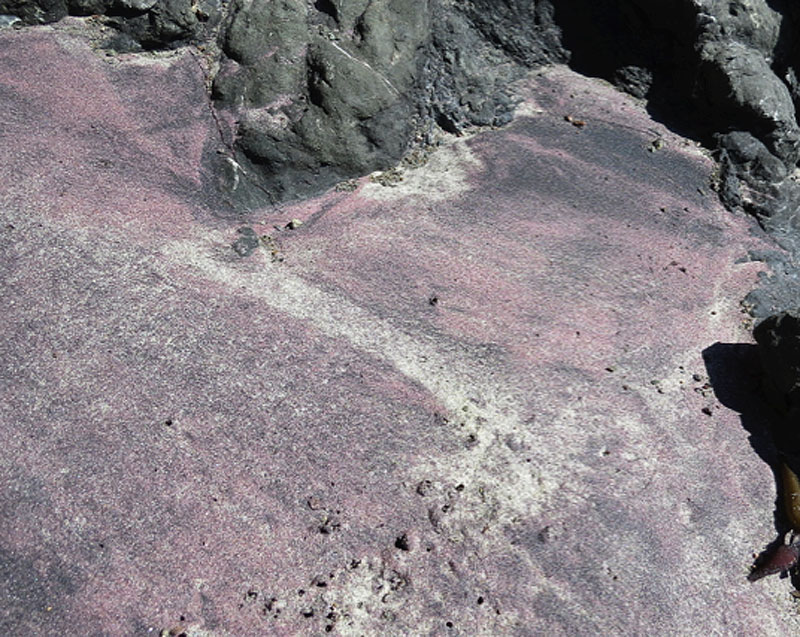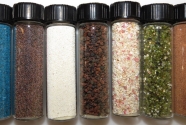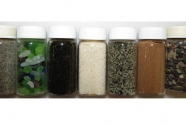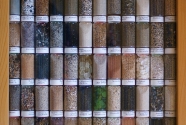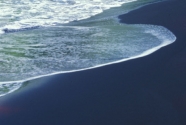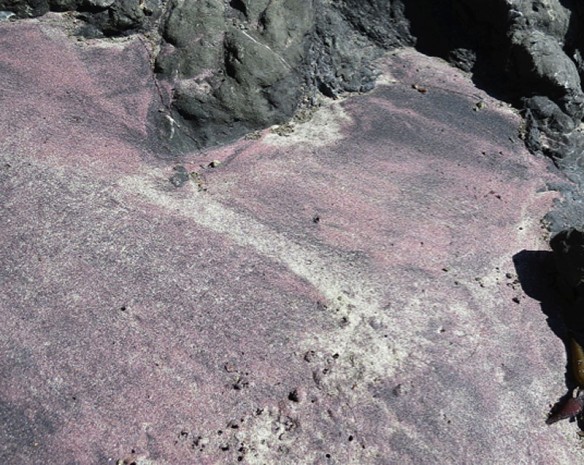
By Gary Griggs, Distinguished Professor of Earth and Planetary Sciences, Director Institute of Marine Sciences, University of California, Santa Cruz, California
The words beach sand or beach probably conjures up a slightly different image for each of us. It might be the place where you spent summer vacations, the beach where you grew up, the beach on that travel poster of Tahiti that’s on your bucket list, or any of a number of other memorable experiences. And while many of our images of beach sand might be similar, beach sand can vary widely in size, shape and color.
The beach sand on the shoreline of the 30-mile long, crescent-shaped, Monterey Bay, California, where I’ve lived and studied beaches for 46 years, is downright plain throughout most of the year. The tan or buff color comes from a mixture of quartz and feldspar, durable minerals that have eroded from the sandstones and granite in the surrounding watersheds, carried to the shoreline by the rivers and creeks, and then worn, sorted, and rounded by wave action. It’s pretty typical looking stuff.
In the winter months, however, you can find black sand along some of Monterey Bay’s beaches. Because these dark minerals are heavier than the clear or lighter colored quartz and feldspar that make up the great bulk of most of the bay’s beach sands, the more energetic winter waves will wash the lighter minerals offshore and often concentrate these darker minerals into black sand beaches. The black or dark minerals, such as magnetite, ilmenite, and chromite, can be separated from the lighter colored sand by a hand magnet, like you used to do in the sand box as a child- well some of us who played in sand boxes did. These dark minerals contain heavy elements such as iron, magnesium, titanium, and chromium, and these denser grains are left behind by the large winter waves as they remove the less dense quartz and feldspar. The black sand will often be concentrated in small rills, channels, or in the troughs of the ripples on the beach surface.
The processes that concentrate these heavier minerals on beaches are similar to those that left gold behind in the streams of the Sierra foothills. Currents, whether in rivers or driven by waves or tidal fluctuations along the shoreline, will tend to sort out or separate the lighter from the heavier minerals. These concentrations of minerals are known as placer deposits and led to California’s Gold Rush. The beaches and shallow offshore waters of Australia are the source for about 95% of the world’s rutile, an important titanium mineral, as well as gold, zirconium, tin and chromium bearing minerals. Much of the world’s tin comes from similar sand deposits along the coasts of Malaysia, Indonesia and Thailand.
Twenty-five miles south of Monterey Bay at the mouth of the Big Sur River, a picturesque walk from Highway 1 through Andrew Molera State Park, you can find purple beach sand. The purple is from a very hard mineral, garnet, which weathers out of metamorphic rocks high in the adjacent Santa Lucia Range. Much of the sand paper you use is coated with garnet because it is a hard and abrasive mineral. Wind and waves have concentrated this purple mineral in interesting patterns along the beach for a considerable distance south of the river mouth.
“The color of any beach reflects the mineral composition of the sand grains.”
— Gary Griggs
Two hundred miles north of Monterey Bay, on the Mendocino Coast, lies the old lumber town of Fort Bragg. For decades the local residents used a beach at the north end of town as their city dump. In the days before recycling, anything that couldn’t be burned or fed to the chickens or pigs was dumped at some out of sight and convenient location. This was common in rural communities everywhere. Over the years the metal rusted away, but the glass was broken up and smoothed by the waves, leaving behind Glass Beach, which has become a popular tourist destination. Visitors spend hours on their hands and knees looking for their own treasures derived from Grandpa’s old beer bottles and Grandma’s old broken cups and saucers.
While an Oceanography graduate student at Oregon State University, I had the opportunity to spend a summer studying the coral reefs of Bermuda, about 600 miles off the Atlantic coast. Bermuda advertises its “pink coral sands” as an attraction to draw tourists. And they are pink, but it’s not coral that gives them this color. It’s actually a less familiar organism, a single cell animal known as a foraminifera, which makes a small pinkish shell. Although not particularly abundant, the small amount of pink in the otherwise white sand gives a distinct color to the beaches of Bermuda.
Three thousand miles west in the Hawaiian Islands, there are really only two things to make beach sand out of, either volcanic rock or coral and the shells of other tropical organisms. As a result, you either see gleaming white beaches or black sand beaches, often with concentrations of a green mineral, olivine, common in the basaltic lava that makes up Hawaii. At Hana, on the east coast of Maui, there are coarse-grained volcanic sand beaches, that contain both black grains of basalt, and also more weathered volcanic grains that are a rusty brown color.
The color of any beach reflects the mineral composition of the sand grains. Whether derived from the local bluffs or cliffs, the rivers and creeks that drain to the coast, or the organisms that may populate the near shore area, coral or coralline algae, mollusks, foraminifera or any of a number of other invertebrates that make hard skeletons or shells, it is these locally derived materials that make each beach a little different and somewhat unique.
My attraction to beach sand started when I began traveling to different coasts and noticed how many different colors of beach sand there were. So I started collecting small samples in 35mm film containers, which no longer are as common as they used to be. I then put these in glass vials and started putting them on bookshelves and windowsills. Over the past 50 years I have collected several hundred of these from all over the world. Nearly all of these bring back memories and, even while sitting in my office, they give me a sense of being back on the beach somewhere. Over the years, friends began sending me samples they had collected to add to my collection, from places I hadn’t been, Antarctica (which has beaches), Easter Island, Argentina, and Bora Bora, to name a few.
Not long ago I discovered that I wasn’t the only one who collected beach sand and that there was a name given to these collectors, arenophiles! The prefix “arena” such as is used to describe sandstones (“arenites”), actually came from the Romans who used to scatter sand around the arena to soak up the blood shed after their coliseum battles.
There is actually The International Sand Collectors Society with a newsletter called the Sand Paper. One of the most interesting beach sand collection sites is The World Atlas of Sands, which contains photographs of thousands of different beach sands that have been displayed in countless different sorts of glass containers by arenophiles worldwide. This site gives a whole new perspective to beach sand.

